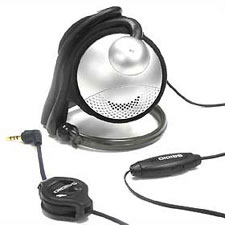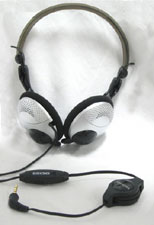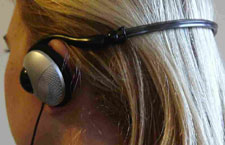 As the Treo becomes more of an all-in-one communication, information and entertainment device, with many users emphasizing entertainment, it seems only natural that there should be a single listening accessory that can perform double-duty: serve as a wired headset for phone calls and as stereo headphones for listening to your favorite tunes. Seidio, a pioneer manufacturer of accessories for mobile devices, has recently released several new versions of their 2-in-1 headphones for the Treo 650 that are up to this challenge. This review focuses on the foldable version, which theoretically should take up less space when not in use.
As the Treo becomes more of an all-in-one communication, information and entertainment device, with many users emphasizing entertainment, it seems only natural that there should be a single listening accessory that can perform double-duty: serve as a wired headset for phone calls and as stereo headphones for listening to your favorite tunes. Seidio, a pioneer manufacturer of accessories for mobile devices, has recently released several new versions of their 2-in-1 headphones for the Treo 650 that are up to this challenge. This review focuses on the foldable version, which theoretically should take up less space when not in use.
In brief, the fact that these headphones worked right out of the box was a real plus. And for those tired of dealing with messy, tangled wires, the retractable cable is another high point..
As for foldability, Seidio needs to go back to the drawing board. Although these headphones fold, they don�t crunch down into a neat little package like some others. Despite that, they work like a charm, allowing you to listen to music and deal with incoming calls with a one-touch button. They are well worth considering, in spite of a few trade-offs.
Design
Seidio has done a decent job dealing with a device that is very subjective�headphones. Some prefer the totally around-the-ear (circumaural) style while others like on-ear (supra-aural) or in-the-ear style. And still others like the behind-the-head option. The cans in this review feature a retractable cord, wrap around the back of your head (AKA backphone) and are foldable (more on that later).
The first thing that grabbed my attention was that these headphones come out of the box with a 2.5mm jack, which means they�ll plug straight into the Treo without the need for an adapter. That�s smart. The small, dedicated plug of the Seidio headphones also saves wear and tear on the Treo�s built-in jack, which I�ve learned from experience is very delicate and doesn�t take kindly to adapters.Note: With an inexpensive adapter from Radio Shack, these headphones can be used with a standard 3.5mm stereo mini-jack found on most all portable players and laptops.
 Right next to the headphone plug is the retracting spool. This is a spring-loaded reel-in device you've probably seen on other newish Treo accessories like some sync/charging cables - it neatly coils the headphones' cable inside. To make it work, pull the cable out from both sides to the desired length and let it click into place. Later, just pull and release to recoil � just like the power cord found on some vacuum cleaners. The coiling cable itself is flat and thin, which helps reduce tangles. Could the retractor be a weak link? Only time and lots of use will tell. Overall, the mechanism has solid feel.
Right next to the headphone plug is the retracting spool. This is a spring-loaded reel-in device you've probably seen on other newish Treo accessories like some sync/charging cables - it neatly coils the headphones' cable inside. To make it work, pull the cable out from both sides to the desired length and let it click into place. Later, just pull and release to recoil � just like the power cord found on some vacuum cleaners. The coiling cable itself is flat and thin, which helps reduce tangles. Could the retractor be a weak link? Only time and lots of use will tell. Overall, the mechanism has solid feel.
Next up the cord is the in-line volume control button that lets you adjust your music or phone call volume. There�s a one-touch button for answering and hanging up calls. The mic can be found hiding underneath three small hash marks. Finally, near the headphones themselves, is a standard rotating lapel clip.
The headphones have relatively large, foam covered speakers that rest gently against the ears. Visually, these headphones probably won�t win any design awards for flashy looks: The outside speaker housings are gray plastic while the rest of the unit is black. The headphones hook over the ears with a flexible semi-translucent gray band that makes an arc around the back of your head. However, this band is not adjustable. The one-size-fits-all approach is not ideal; people don't all have the same size noggins. This band has hinges for the folding mechanism.
Functionality
Let�s start with that folding system. While it does technically fold, it doesn�t collapse down into a neat little package like some others of this style. To me, it looked more like a tiny teepee on my desk. The retractable cable unfurls and retracts with ease. Note: Always avoid pulling just one side. This will create a tangled mess, which is what having a retractable is supposed to help you prevent. Instead, make sure to pull gently and consistently from both sides of the retractor. If you do end up with a tangled cord, pull it gently until the cord is fully extended on both sides. Then it will retract properly.
The volume control wheel works well. The call control button works with a satisfying click. The headphones sit comfortably due to the back band, which is just pliable enough without feeling either weak or flimsy. So, what�s not to like?
The trade-off for having a decent working retractable cable is that the mechanism adds weight to the cord, and tends to drag a bit on the cable. And it�s puzzling to me that they don�t ship with any sort of case and the folding mechanism seems incomplete when it comes to storing or traveling with them.
Sound Matters
Choosing headphones is a highly subjective matter. What I discovered during this review process is that I�m really not a huge fan of the behind the neck headphones. They put too much strain on my delicate ears for my taste. Sometimes this type of style is referred to as �sport headphones� because they are designed to not interfere with helmets and work well for jogging.
Headphones, like loudspeakers, are designed and rated to perform within a given frequency range, the wider, the better. Frequency response is typically used as a way of measuring and comparing headphone
performance. Expressed as two numbers from Hz to kHz (sound wave cycle per second), it refers to the
lowest and highest audio frequencies that the headphones can reproduce. For
example, high-end headphones such as the Sony Pro MDR-7506 (SRP $130) have a
frequency response range of 10Hz-20kHz.
Seidio's 2-in-1 headphones (SRP $49), on the other hand, have a rated range of
20Hz-20kHz (which maps them to what's considered the optimal frequency
response of the human ear, although few humans can hear higher than 18kHz).
So what does this mean? High-end headphones or speakers are
designed to faithfully reproduce those thunderous, fundamental lows, clear, non-honky or muddy mids and crystal clear highs, making well-produced tracks from U2, Pink Floyd, The Beatles, or anything from a string quartet to Dave Brubeck to a full symphony orchestra sound true-to-life, without adding coloration.
 Good headphones, like good speakers should simply sound like music. Studio engineers spend hundreds of hours hunched over very expensive consoles, mixing down recorded music, whatever it is. Speakers or headphones are THE most single important element in the whole audio chain. So they should reproduce faithfully and accurately what the engineers worked so hard to create. If you want to change what
Good headphones, like good speakers should simply sound like music. Studio engineers spend hundreds of hours hunched over very expensive consoles, mixing down recorded music, whatever it is. Speakers or headphones are THE most single important element in the whole audio chain. So they should reproduce faithfully and accurately what the engineers worked so hard to create. If you want to change what
comes out of your speakers or headphones to suit your own
listening taste or environment, it should be done with
your own tone controls or graphic equalizer, not by the speakers
or headphones coloring the sound themselves.
While the rated frequency response of the Seidio's 2-in-1 looks good on paper, rated specs are one thing; actual listening tells a different tale, especially in the mid-range (leaving the vocals sounding rather muddy), but these headphones are a huge step up from the standard earbuds many use on a daily basis. The 2-in-1 has much better bass and high end reproduction than earbuds.
Also, Seidio's phones do a reasonable job of masking out external noise. Though they don't isolate ambient sound as well as either earplugs or over-the-ear phones, they actually made an older Billie Holiday recording from my library sound better than it did on the high-end Sony headphones.
Ironically, Sony's high-end pro level headphones faithfully reproduced all the flaws of that old recording; Seidio�s unit, on the other hand, filtered out some of the noise, so that the track actually sounded better to me.
But I can't stress enough that headphones are a very personal thing, verging on religion, and the subject of endless debate amongst audiophiles. Note: To optimize your Treo�s sound, if you rip your own MP3s, try upping your MP3 encoding from 128-bit to 160-fixed or variable bit rate. This provides a great compromise between sound quality and file size. Another thing to try is Normsoft�s PocketTunes, which has become the standard for the Treo. It features a five-band graphic EQ that enables you to make adjustments to meet your taste.
When used as a telephone headset for calls, I found using these quite enjoyable and an improvement over any of the Bluetooth headsets I�ve tested. People I�ve called reported that my voice sounded very clear (and the best they�ve heard from headsets that I�ve tested).
One thing that took some getting used to was hearing a caller in both ears, since phone calls are mono, their voices seemed to float in the middle of my head, since we are so accustomed to one-eared phone calls (unless you use your Treo's speaker phone feature). At first disconcerting, I�ve grown to appreciate it.
One last note about Seidio's design: the corded mic hangs just under your chin and this is fine in most environments. However, if you�re somewhere with a lot of background noise, you should just switch over to the Treo itself.
Conclusion >>
Copyright 1999-2016 TreoCentral. All rights reserved :
Terms of Use : Privacy Policy
TREO and TreoCentral are trademarks or registered trademarks of palm, Inc. in the United States and other countries;
the TreoCentral mark and domain name are used under license from palm, Inc.
The views expressed on this website are solely those of the proprietor, or
contributors to the site, and do not necessarily reflect the views of palm, Inc.
Read Merciful by Casey Adolfsson
 As the Treo becomes more of an all-in-one communication, information and entertainment device, with many users emphasizing entertainment, it seems only natural that there should be a single listening accessory that can perform double-duty: serve as a wired headset for phone calls and as stereo headphones for listening to your favorite tunes. Seidio, a pioneer manufacturer of accessories for mobile devices, has recently released several new versions of their 2-in-1 headphones for the Treo 650 that are up to this challenge. This review focuses on the foldable version, which theoretically should take up less space when not in use.
As the Treo becomes more of an all-in-one communication, information and entertainment device, with many users emphasizing entertainment, it seems only natural that there should be a single listening accessory that can perform double-duty: serve as a wired headset for phone calls and as stereo headphones for listening to your favorite tunes. Seidio, a pioneer manufacturer of accessories for mobile devices, has recently released several new versions of their 2-in-1 headphones for the Treo 650 that are up to this challenge. This review focuses on the foldable version, which theoretically should take up less space when not in use.
 Right next to the headphone plug is the retracting spool. This is a spring-loaded reel-in device you've probably seen on other newish Treo accessories like some sync/charging cables - it neatly coils the headphones' cable inside. To make it work, pull the cable out from both sides to the desired length and let it click into place. Later, just pull and release to recoil � just like the power cord found on some vacuum cleaners. The coiling cable itself is flat and thin, which helps reduce tangles. Could the retractor be a weak link? Only time and lots of use will tell. Overall, the mechanism has solid feel.
Right next to the headphone plug is the retracting spool. This is a spring-loaded reel-in device you've probably seen on other newish Treo accessories like some sync/charging cables - it neatly coils the headphones' cable inside. To make it work, pull the cable out from both sides to the desired length and let it click into place. Later, just pull and release to recoil � just like the power cord found on some vacuum cleaners. The coiling cable itself is flat and thin, which helps reduce tangles. Could the retractor be a weak link? Only time and lots of use will tell. Overall, the mechanism has solid feel.
 Good headphones, like good speakers should simply sound like music. Studio engineers spend hundreds of hours hunched over very expensive consoles, mixing down recorded music, whatever it is. Speakers or headphones are THE most single important element in the whole audio chain. So they should reproduce faithfully and accurately what the engineers worked so hard to create. If you want to change what
Good headphones, like good speakers should simply sound like music. Studio engineers spend hundreds of hours hunched over very expensive consoles, mixing down recorded music, whatever it is. Speakers or headphones are THE most single important element in the whole audio chain. So they should reproduce faithfully and accurately what the engineers worked so hard to create. If you want to change what